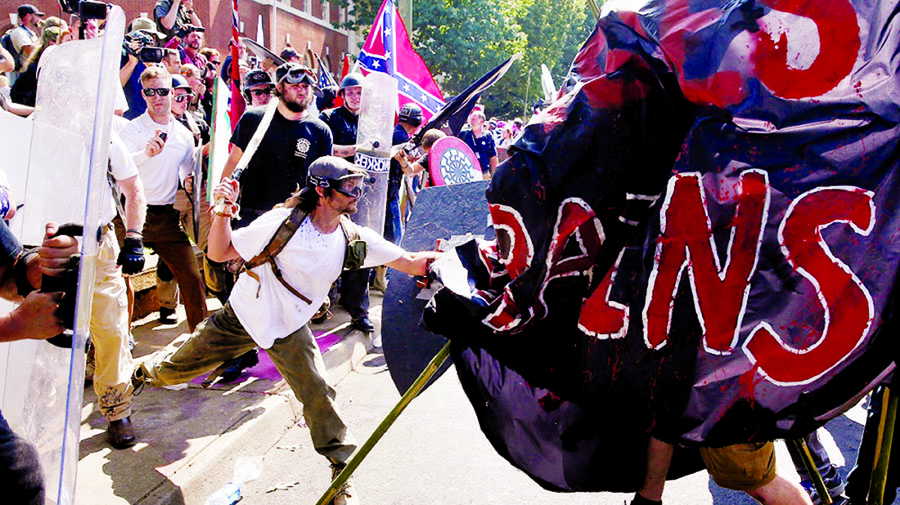
Leading figures in Donald Trump’s Republican party have reacted angrily to his latest comments blaming both sides for the violent clashes in Charlottesville, Virginia, on Saturday.
They culminated with a person being killed and many injured when a car hit people opposed to a far-right rally.
Many echoed House Speaker Paul Ryan who said: “White supremacy is repulsive.. There can be no moral ambiguity.” Mr Trump had condemned white supremacist groups on Monday. But on Tuesday he reverted to his initial reaction. The right-wing march had been organised to protest against the proposed removal of a statue of Gen Robert E Lee, who commanded the pro-slavery Confederate forces during the American Civil War. The event drew white supremacy groups.
Violence broke out after they were confronted by anti-fascism groups. A BBC correspondent at the scene described how members of the so-called “alt-right” openly carried rifles and were dressed in full tactical gear. Their leftist rivals threw bottles, rocks and paint. Pepper spray was used by both sides.
“I think there is blame on both sides,” Mr Trump told reporters at a tense press conference at Trump Tower in New York. “You had a group on one side that was bad. You had a group on the other side that was also very violent. Nobody wants to say that. I’ll say it right now.” “What about the alt-left that came charging… at the, as you say, the alt-right? Do they have any semblance of guilt? (…) There are two sides to a story,” Mr Trump said in response to one reporter. He condemned the driver of a car that ploughed into one group of anti-racism protesters, killing 32-year-old Heather Heyer and injuring 19 others. But he said that those who had marched in defence of the statue had included “many fine people”; and he asked whether statues of former presidents George Washington and Thomas Jefferson should also be torn down, because they had been slave-owners.
His comments were said to have caught senior White House officials off guard. One official, who was not authorised to speak publicly, told CNN it had been agreed that Mr Trump would talk only about infrastructure, which was the reason for the news conference. The Associated Press reported that as Mr Trump spoke, new chief of staff John Kelly barely glanced at the president, press secretary Sarah Huckabee Sanders tried to make eye contact with other top aides, and one young staffer stood with her mouth agape.
But many others strongly condemned the comments. Of the reactions of some 55 Republican and Democrat politicians collected by the Washington Post, only the spokeswoman for the Republican National Committee, Kayleigh McEnany, expressed her support. Veteran Republican Senator John McCain tweeted: “There is no moral equivalency between racists & Americans standing up to defy hate & bigotry.”
One of Mr Trump’s former rivals for the Republican presidential nomination, Marco Rubio sent a series of tweets. Richard Trumka, president of the AFL-CIO trade union federation, became the fifth prominent business leader to resign from President Trump’s advisory body, the American Manufacturing Council, over the issue. He said he could not take part “for a president who tolerates bigotry and domestic terrorism”.
In another development, the response of former President Barack Obama to the violence in Charlottesville has become the most-liked tweet ever.
The message, quoting Nelson Mandela, reads: “No-one is born hating another person because of the colour of his skin or his background or his religion.” It has been “liked” nearly three million times since being posted on Sunday. On Monday, Donald Trump’s condemnation of the far-right came from advisers counselling him on what was politically necessary to defuse the growing storm following the Charlottesville violence.
On Tuesday, the president said what he really thought. Although he initially explained away the delay in condemnations of white supremacists as necessary for him to gather “the facts” of the situation, the nature of the protests were quite evident by the evening before, when demonstrators chanting white supremacist slogans held a torchlight parade through Charlottesville. In any regard, Mr Trump has shown little reluctance in jumping to conclusions about violent incidents when it appears Islamist extremism is at play.
Upon further questioning, it became clear that the president views the Charlottesville unrest as far from a one-sided affair. Mixed in among the white supremacists, he said, were some good, peaceful people protesting the removal of a statue (of a man who led an army against the US government). And there were plenty of violent individuals among the counter-protesters as well.
When the president on Saturday said there were “many sides” to blame, he meant it.
If Donald Trump’s initial handling of the fallout from Charlottesville started a political fire, on Tuesday the president poured on a bucket of kerosene and danced around the flames.

